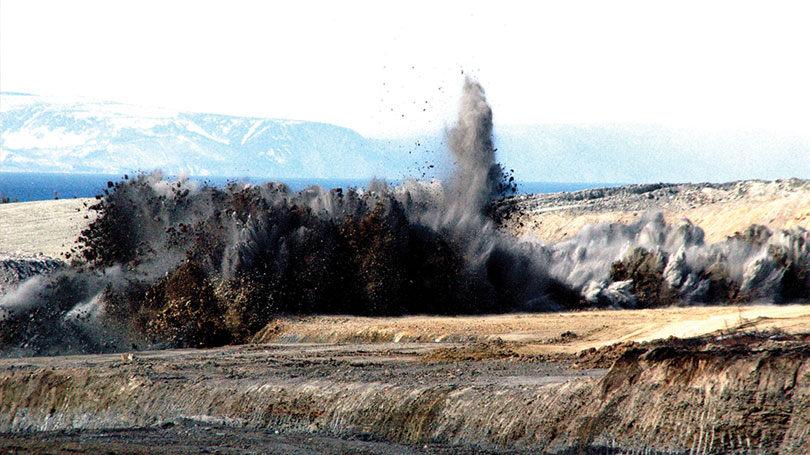Alternative explosives

Challenge
For over 60 years, ammonium nitrate (AN) based commercial explosives have been unchallenged although while highly effective, they have drawbacks. These explosives don’t always detonate efficiently due to a number of uncontrollable and complex factors. This can lead to the generation of harmful nitrogen oxide (NOx) fumes which pose serious health risks to both humans and the environment.
The drawbacks can also cause significant production delays in both surface and underground operations. Currently there are engineering and administrative controls in place to minimise the risk of NOx fumes, but not an option to eliminate the issue entirely.
Furthermore, the production of Ammonium nitrate is currently a carbon-intensive process, that requires large scale plant and capital investment.
Research
Mining3 is testing alternative explosive formulations which eliminate the nitrogen component and replaces it with hydrogen peroxide as the main oxidising agent. By removing the nitrogen component of the explosive formulation, it completely eliminates any NOx fumes generated after blasting and significantly reduces O2 intensity of the blasting process.
A variety of applications are envisaged for this novel technology. On-site preparation will eliminate the risk and need for lengthy explosives transportation, where a cartridge or bulk material is envisaged for the varied commercial applications. Alternative sources of recycled compounds have also been incorporated to further enhance the sustainability and manufacturing costs of this revolutionary new technology, and a variety of materials can be utilised for product sensitisation.
More recently, a number of tests conducted in high-temperature field conditions at Rurex’s Byrock detonation range improved explosive performance, reliability, and product stability. The western NSW location also provided the opportunity to manufacture prototype cartridges for packing the explosives, to be used in underground and secondary blasting scenarios.
Tests in over 400 unconfined detonations at Byrock and Mining3’s onsite blast chamber have characterised the formulas performance, and small-scale quarry bench blasts have demonstrated the ability to match the rock breakage capability of current explosives.
The explosives have successfully completed UN Testing.
Benefits
- Less impact on the environment through the elimination of nitrates and decarbonisation of blasting.
- Bulk quantities of readily available oxidiser globally
- Use of sustainable and renewable fuels in explosive formulations
- Simple, scalable and less energy-intensive manufacturing system
- Flexible manufacturing allowing operations to self-supply explosives
- A lower cost of units delivery with no thermal component is required
- Simplicity and flexibility provide the opportunity for reducing specialist manufacturing and application personnel, and potentially tele-remote or a full automation of blasting services processes
- Reduced public risk with fewer blasting agents being transported on public roads thus reducing public risk
- Decreased requirements for explosives storage and transport, including reducing carbon footprint of transport.
Status
Mining3 is working with ACARP and its members to scale up the project and continue with site-based trials to enhance the overall formulation. The research can be applied in underground, surface, and secondary blasting scenarios.
Additional projects are planned to improve mine site deployability and scale.
The project is currently in a pre-commercial phase. Mining3 is seeking commercial partners to progress Alternative Explosives into a market-ready product.
Factsheet
Access the latest Alternative Explosives factsheet.








